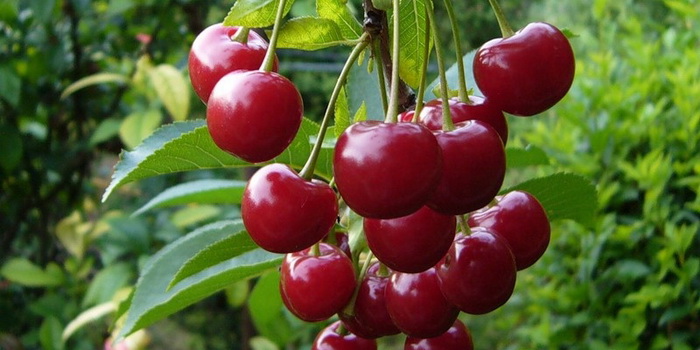The goal of each gardener in planting a fruit tree is a stable yield and high quality of fruits. It is precisely these qualities that the Lyubskaya variety has, which is rightfully considered to be a Russian variety.
Table of contents
Characteristic cherry varieties "Lyubskaya"
The Lyubskaya cherry owes its varietal qualities to the long-term work of amateur gardeners, who gradually adapted it to the climatic conditions of central Russia.Historical facts indicate a more accurate place of origin - Kursk Province, where this sort of cherry tree was passed down from generation to generation.
The first scientific description of the cherry was made in the 30s of the XX century. During this period, the doctor of agricultural sciences and the scientist N. I. Kichunov paid attention to the distinctive qualities of the fruit tree. In 1947, breeding studies were carried out, according to the results of which the Lubskaya cherry was entered in the USSR State Varietal Register.
Cherry variety "Lyubskaya" refers to the type of ordinary cherry. Representatives of this species have many common morphological features with features characteristic only for a certain variety.
Tree structure
This is a bush tree, reaching a height of 2.5 meters. The bark of the cherry "Lyubskaya" is gray-brown in color with numerous transverse lentils - openings for gas exchange.
The crown of the cherry tree is spherical and of medium thickness. A characteristic feature of the variety is wilted annual branches covered with brown bark with silver patina. The stable average deviation angle of the branches from the trunk is 45 °.
Every year, “Lyubskaya” cherry, under favorable conditions, gives a 30-40 cm increase, where the next year the fruits are formed. After collecting the fruits, these branches become bare, and the fruiting gradually passes to the periphery of the crown.
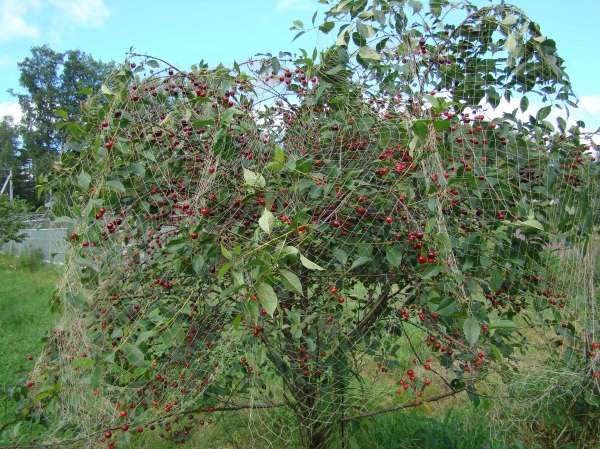
Leaves and flowers
The leaves of the tree of this variety have a narrowed oval shape with a pointed end. Along the edges there are numerous notches. They have a rather dense texture and dark green color. At the place of transition to the scape you can see yellowish streaks. The average size of an adult sheet is 87 mm by 50 mm.
Cherry flowers "Lyubskaya" are white and are assembled in umbrellas of 2-3 pieces. They are formed by five sepals and petals, planted on a pedicel 25 mm long.
Fruit
The main light of ripe fruits of Lubskaya cherry is dark red, which can vary depending on the intensity of photosynthesis. Under the thin glossy peel hides the juicy flesh, the color of which often repeats the shade of the skin. The stone is small, takes 6-8% of the total fetus. Quite easily separated from the pulp.
The fruits have an oval-round shape and an average weight of 4 grams. They mainly grow in groups of 2-4 berries, attached to the shoot with sturdy stalk.Cherry berries "Lyubskaya" appreciated for a balanced taste and rich mineral composition, which allows them to be considered as a dietary product.
Root system
The root system of Lubskoy cherry is formed from horizontal and vertical roots. Horizontal roots depart from the root collar at a depth of 10-30 cm and 1.5 times the crown projection. Vertical roots can be up to 2 m deep. The bulk of overgrown roots is concentrated to a depth of 40 cm.
Grade advantages:
- Self-fertility. Ability to be fertilized by your own pollen. This gives Lubskaya cherry a great advantage: independence from the natural conditions that affect the life cycle of pollinating insects.
- Medium late bloom. Fruit set begins only when a stable climate is established, when there are no temperature drops and the threat of sudden frosts is minimal. This contributes to the stability of the crop.
- Terms of fruiting. If all the recommended rules of agrotechnology are observed, one can enjoy the first harvest of the “Lyubskaya” cherry 2-3 years after planting. Despite the relatively late flowering cherry "Lyubskaya" - skonoplodny grade. Full ripening occurs in late July and early August.
- Productivity. This indicator is growing rapidly and is stable. Under the conditions of the middle lane, 25 kg of berries can be collected from each medium tree, in the southern regions up to 35 kg.
- Easy care. The compactness of the shrub facilitates pruning and harvesting.
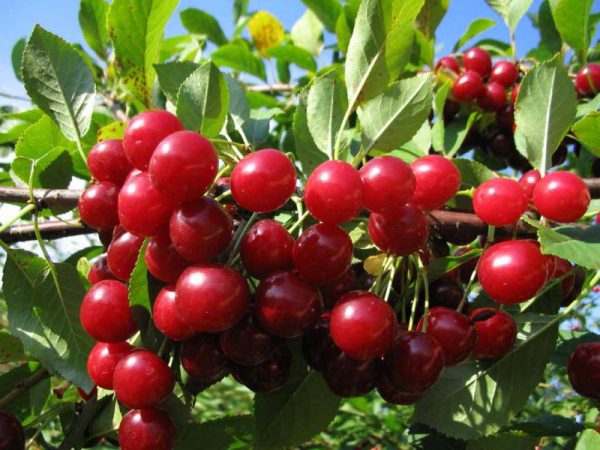
The disadvantages of the variety:
- Frost resistance. Average frost resistance allows cultivating this sort of cherry only within the middle band and in the southern regions. When planting in the northern areas of the trees do not take root.
- Winter hardiness Because of the peculiarities of the structure of the bark, cracks often appear on the cherry stem after temperature drops. This makes the tree defenseless against fungal and viral diseases. Damage to the cambium leads to a general weakening of the cherry.
- Lifespan. The constant cost of domestic resources to ensure a stable and high yield leads to rapid wear of the fruit tree.Therefore, the life of cherry "Lyubskaya" is low and is inferior in this indicator to many varieties. In the middle lane a tree lives up to 15 years, in more southern regions it is up to 25 years.
- The acidity of the fruit. Cherry berries have a high acidity. Therefore, they are mainly used only for culinary preparations.
Planting cherries "Lyubskaya"
You can buy high-quality seedlings for planting in nurseries or garden centers. The best survival rate of seedlings up to two years.
Selection of seedlings
When choosing a seedling, it is important to pay attention to the quality indicators. The vertical root should have at least 30 cm and a mass of overgrowing roots. The health of the roots can be judged by elasticity, the absence of traces of mechanical damage, rot and growths. Crohn seedlings should be sufficiently developed with healthy skeletal branches. Bark elastic without cracks, flaking and damage.
After buying a seedling, it is important not to let the roots dry out. To do this, they are wrapped in a wet burlap and several layers of thin paper. Also it is impossible to allow hit on a sapling of direct sunshine.
Site selection and preparation
Proper site selection and careful preparation of the soil relieves gardeners of many problems, ensures healthy growth and balanced fruiting of cherries. For the fruit tree, an illuminated area is selected, protected from northern winds and drafts. Groundwater deposition should be no higher than 3 m.
The ideal option is a hill facing south or south-west.. In such areas moisture does not stagnate and good air exchange. After selecting a site, it is important to prepare it in advance. For spring planting in the fall, and if you plan to plant in the winter, at the beginning of summer.
For all varieties of cherries, sandy soils with neutral acidity are preferred.Plants planted without taking into account the alkaline reaction of the soil, poorly absorbed by trace elements and often get sick. Therefore, each gardener must know the level of acidity of the soil in his area and, if necessary, adjust it to different plants.
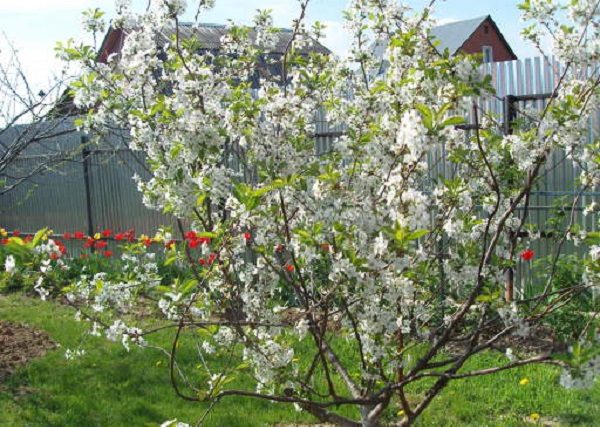
Especially painful are this indicator cherries. Therefore, if the acidity is high, limestone is applied to the plot at the rate of 0.5 kg per 1 sq.2. The plot is fed with organic matter and minerals, for 1 m2 contribute:
- 10 kg manure or compost;
- superphosphate 100 g;
- potassium sulfate 100 g
The optimal depth of the pit is 60 cm, diameter - 80 cm. It is important to shape the walls by steep ones - this reduces the degree of shrinkage. The soil from the top of the pit is set aside, it will be used to mix the substrate.
After digging a hole, a layer of limestone rubble is laid on the bottom, which will serve as a drainage and acidity regulator. For the garter of a seedling, a stake is stuck whose height is 1 m above the ground level. After that prepare the substrate:
- humus 3 buckets;
- phosphate rock 1 kg;
- potassium sulfate 150 g
All these components are mixed with the deposited soil. Thus, the prepared in advance soil mixture is structured, and the minerals and nutrients will take up the forms absorbed by young roots.
You may be interested in the following articles about fruit trees:
Planting seedlings
For planting in the southern regions choose the autumn season - October or the first decade of November. In the middle lane cherry "Lyubskaya" planted in September or in mid-April.
Before planting the roots of the seedling inspect again. Sharp pruners remove damaged parts. It is important to hold dried roots in warm water for 12 hours.
Stages of planting seedlings:
- In the center of the landing pit is formed a mound of the prepared substrate, are guided by the root neck.It should remain above the ground level by 5 cm when planting the base of the seedling on the surface of the mound.
- Seedling roots evenly spread on the substrate. It is important to avoid unnatural bends. After that, they are covered with soil mixture, avoiding the formation of voids.
- The near-barrel circle is tamped and poured over two buckets of warm water. After water is completely absorbed, soil is added to the voids, and the surface is mulched with peat or sawdust.
Thus, the young cherries are provided with all the comfortable conditions for rooting and gaining strength before the first winter.
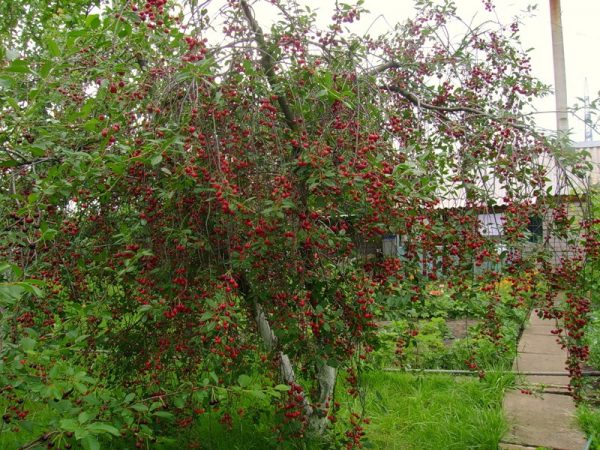
Basics of caring for Lubskaya cherry
Rules for the care of a fruit tree are drawn up taking into account varietal characteristics, but the gardener must always be guided by the particular climate of the region.
Main events:
- Watering. Abundant irrigation in the phase of formation of shoots, flowering and ripening of fruits. On one average tree will need 30 liters of warm water. If autumn is dry, it is important to conduct water irrigation before frost.
- Top dressing. The first fertilizers begin 1-2 years after planting. Organic fertilizing is carried out twice during the growing season,for this manure or compost is used. In the fall, phosphorus and potash fertilizers are applied to the tree trunk circle, in the spring - nitrogen fertilizers. Immediately after flowering, the tree is fed with mineral complexes.
- Loosening. In order to increase the aeration is carried out three times during the growing season.
- Mulching. Constantly need to monitor the status of the layer of mulch. It can hide pests or form spores of fungi. Therefore, mulch must be periodically changed.
- Crop. It is carried out before bud break. During this procedure, excessively overgrown and damaged branches are cut, and the seedlings are removed. Autumn rejuvenating pruning carried out.
- Shelter for the winter. The cherries are wrapped in warm material and covered with spruce branches. Pristvolny circle mulch dense layer of peat (30 cm). In winter, snow is pulled up to the tree.
Pests and diseases
Most often Lubskaya cherry affects the fungal disease coccomycosis. This is manifested by the appearance on the outside of the leaves of red-brown spots and the formation of pink-gray pads on the back. This is a dangerous disease that leads to crop loss, and without the lack of treatment and the fruit tree.
Treatment of coccomycosis:
- Spraying the tree and the near-stem circle with a copper-containing fungicide in the kidney swelling phase. Used drug "Abiga-Peak", diluted in water (50 ml / 10 l).
- Treatment of cherries with the preparation “Chorus” (3g / 10 l) in the phase of setting the buds.
- If the activities did not help, two weeks after the end of flowering, all the affected branches of the tree are cut and burned. Cherry is treated with the drug "Scor" (1 ampoule / 10l).
- After harvesting, the tree is treated with Bordeaux liquor (1%).
Most often on a cherry colonies aphids and various gnawing pests settle. With a moderate amount of them you can handle folk remedies. To do this, apply the oil-soap solution (400g / 50g / 10l), decoctions of onion peel, tops of tomatoes or chamomile.
In the case of a massive lesion, it is necessary to use chemicals: "Karbofos""Fufanon" for piercing-sucking pests. “Bankol”, “Aktellik” against gnawing insects.
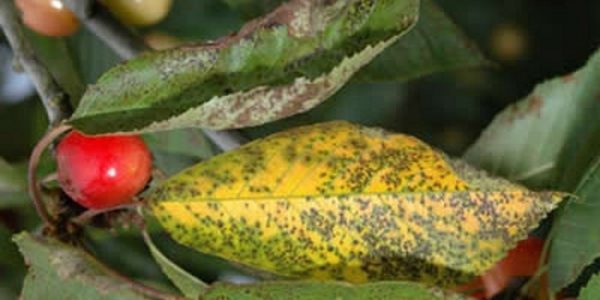
Harvesting and Storage
Harvesting is carried out in one step. This will protect against crop loss, which is very attractive for birds. Cherry berries do not ripen after separation from the tree. Therefore, you should not collect them in advance, counting on the maturation in the boxes. Such fruits are practically not suitable for consumption..
Harvesting is better to spend in the afternoonwhen the morning dew evaporates and the sun's rays are weakened.
The coincidence of the ripening phase of the fruit and the rainy season can lead to the loss of part of the crop. High moisture content in the soil and the external impact affects the quality of the fruit and contributes to the formation of rot. Therefore, it is important to process this batch of berries as quickly as possible.
If you plan to transport the berries, then they are cut off with petioles. This greatly increases the shelf life. Fruits collected without petioles, it is important to process within a day.
Harvest is stored in boxes or baskets with good aeration at temperatures ranging from 0 ° C to -1 ° C. and air humidity of 85%. Such conditions allow preserving the quality of fruits up to 10 days. Hermetic packing in plastic bags prolongs shelf life twice. Fruits can be subjected to deep freezing, which allows you to save taste and healthy qualities for a long period.
Reviews
Natalia: In my garden, this sort of cherry has been growing since 2010. The first time bloomed in the third season, but the harvest was very poor. But the cherry quickly went into growth and today it is a full-fledged tree. This year, collected 12 kg of crop. Berries are great for compotes and jams.
Alexandra: I took a sapling from relatives, and he surprisingly quickly got accustomed. Cherry began to bear fruit after 3 years, and every year the crop increases. The only difficulty is the winter period, for warming I carefully wind the tree and cover with spruce branches. Despite this, you can still notice some damage in the spring, especially freezers.
Successful cultivation of fruit trees is possible only with a full understanding of the varietal characteristics. The weak side of Lubskaya cherry is winter hardiness and susceptibility to fungal diseases. The prevention of these particular deficiencies must first be paid attention to.In return, the fruit tree will thank for stable and high yield for many years.
